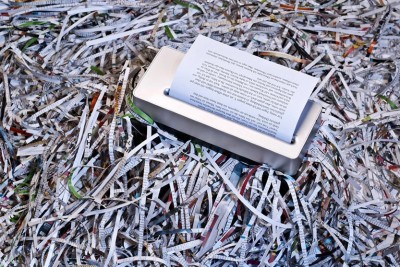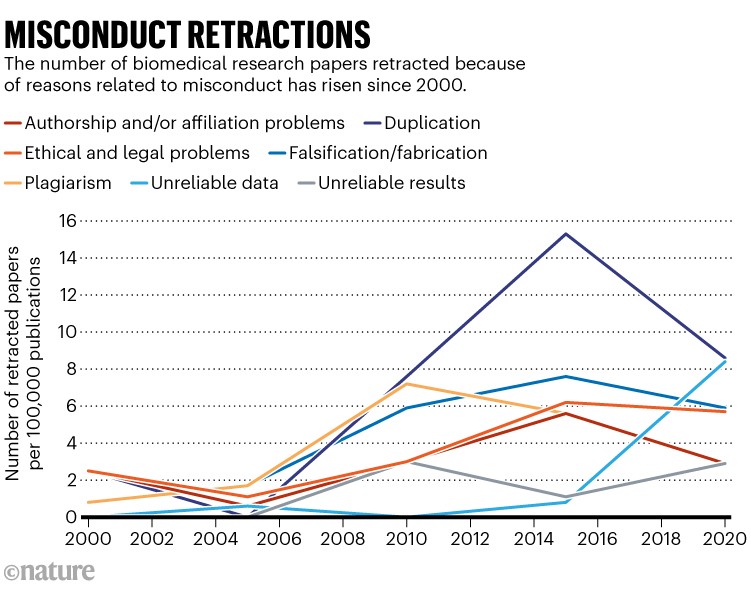Biomedical paper retractions have quadrupled in 20 years — why?
Unreliable data, falsification and other issues related to misconduct are driving a growing proportion of retractions.
The retraction rate for European biomedical-science papers increased fourfold between 2000 and 2021, a study of thousands of retractions has found.
Two-thirds of these papers were withdrawn for reasons relating to research misconduct, such as data and image manipulation or authorship fraud. These factors accounted for an increasing proportion of retractions over the roughly 20-year period, the analysis suggests.
“Our findings indicate that research misconduct has become more prevalent in Europe over the last two decades,” write the authors, led by Alberto Ruano‐Ravina, a public-health researcher at the University of Santiago de Compostela in Spain.
Other research-integrity specialists point out that retractions could be on the rise because researchers and publishers are getting better at investigating and identifying potential misconduct. There are more people working to spot errors and new digital tools to screen publications for suspicious text or data.
Rising retractions
Scholarly publishers have faced increased pressure to clear up the literature in recent years as sleuths have exposed cases of research fraud, identified when peer review has been compromised and uncovered the buying and selling of research articles. Last year saw a record 10,000 papers retracted. Although misconduct is a leading cause of retractions, it is not always responsible: some papers are retracted when authors discover honest errors in their work.

More than 10,000 research papers were retracted in 2023 — a new record
The latest research, published on 4 May in Scientometrics1, looked at more than 2,000 biomedical papers that had a corresponding author based at a European institution and were retracted between 2000 and mid-2021. The data included original articles, reviews, case reports and letters published in English, Spanish or Portuguese. They were listed in a database collated by the media organization Retraction Watch, which records why papers are retracted.
The authors found that overall retraction rates quadrupled during the study period — from around 11 retractions per 100,000 papers in 2000 to almost 45 per 100,000 in 2020. Of all the retracted papers, nearly 67% were withdrawn due to misconduct and around 16% for honest errors. The remaining retractions did not give a reason.
Looking at the papers retracted for misconduct specifically, Ruano‐Ravina and his colleagues found that the major causes have changed over time. In 2000, the highest proportions of retractions were attributed to ethical and legal problems, authorship issues — including dubious or false authorships, objections to authorship by institutions and lack of author approval — and duplication of images, data or large passages of text. By 2020, duplication was still one of the top reasons for retraction, but a similar proportion of papers was retracted owing to ‘unreliable data’ (see ‘Misconduct retractions’).

Source: Ref 1
‘Unreliable data’ refers to studies that cannot be trusted for reasons including original data not being provided and problems with bias or lack of balance. The authors suggest that the rise in retractions attributable to this cause could be related to an increase in the number of papers suspected to be produced by paper mills, businesses that generate fake or poor-quality papers to order.
Authorship problems fell to the joint fifth reason for retractions in 2020. This is “possibly due to the implementation of authorship control systems and increased researcher awareness”, write Ruano‐Ravina and colleagues.
International variation
The study also identified the four European countries that had the highest number of retracted biomedical science papers: Germany, the United Kingdom, Italy and Spain. Each had distinct ‘profiles’ of misconduct-related retractions. In the United Kingdom, for example, falsification was the top reason given for retractions in most years, but the proportion of papers withdrawn because of duplication fell between 2000 and 2020. Meanwhile, Spain and Italy both saw huge rises in the proportion of papers retracted because of duplication.
Arturo Casadevall, a microbiologist at Johns Hopkins University in Baltimore, Maryland, contributed to work that in 2012 found similar rates of paper withdrawal for misconduct2. “To me, this argues that the underlying problems in science have not changed appreciably in the past 12 years,” he says.
But the overall increase in retraction rates could reflect the fact that authors, institutions and journals are increasingly using retractions to correct the literature, he adds.

Science’s fake-paper problem: high-profile effort will tackle paper mills
Sholto David, a biologist and research-integrity specialist based in Wales, UK, points out that methods for detecting errors in research improved during the 20-year study period. An increasing number of people now scan the literature and point out flaws, which could help to explain increasing retraction rates, he says. In particular, the launch of the post-publication peer-review website PubPeer in 2012 has offered sleuths the opportunity to scrutinize papers en masse, he adds, and it has become much more common for researchers to send whistle-blowing e-mails to journals.
Ivan Oransky, Retraction Watch’s co-founder who is based in New York City, suggests that the routine use of plagiarism-detection software by publishers during the past decade might have contributed to the rising rates of retraction because of plagiarism and duplication. It remains to be seen how more recent digital tools, such as those that detect image manipulation, could affect paper withdrawal rates in the coming years, he adds.
doi: https://doi.org/10.1038/d41586-024-01609-0
https://www.nature.com/articles/d41586-024-01609-0
Unreliable data, falsification and other issues related to misconduct are driving a growing proportion of retractions.
The retraction rate for European biomedical-science papers increased fourfold between 2000 and 2021, a study of thousands of retractions has found.
Two-thirds of these papers were withdrawn for reasons relating to research misconduct, such as data and image manipulation or authorship fraud. These factors accounted for an increasing proportion of retractions over the roughly 20-year period, the analysis suggests.
“Our findings indicate that research misconduct has become more prevalent in Europe over the last two decades,” write the authors, led by Alberto Ruano‐Ravina, a public-health researcher at the University of Santiago de Compostela in Spain.
Other research-integrity specialists point out that retractions could be on the rise because researchers and publishers are getting better at investigating and identifying potential misconduct. There are more people working to spot errors and new digital tools to screen publications for suspicious text or data.
Rising retractions
Scholarly publishers have faced increased pressure to clear up the literature in recent years as sleuths have exposed cases of research fraud, identified when peer review has been compromised and uncovered the buying and selling of research articles. Last year saw a record 10,000 papers retracted. Although misconduct is a leading cause of retractions, it is not always responsible: some papers are retracted when authors discover honest errors in their work.

More than 10,000 research papers were retracted in 2023 — a new record
The latest research, published on 4 May in Scientometrics1, looked at more than 2,000 biomedical papers that had a corresponding author based at a European institution and were retracted between 2000 and mid-2021. The data included original articles, reviews, case reports and letters published in English, Spanish or Portuguese. They were listed in a database collated by the media organization Retraction Watch, which records why papers are retracted.
The authors found that overall retraction rates quadrupled during the study period — from around 11 retractions per 100,000 papers in 2000 to almost 45 per 100,000 in 2020. Of all the retracted papers, nearly 67% were withdrawn due to misconduct and around 16% for honest errors. The remaining retractions did not give a reason.
Looking at the papers retracted for misconduct specifically, Ruano‐Ravina and his colleagues found that the major causes have changed over time. In 2000, the highest proportions of retractions were attributed to ethical and legal problems, authorship issues — including dubious or false authorships, objections to authorship by institutions and lack of author approval — and duplication of images, data or large passages of text. By 2020, duplication was still one of the top reasons for retraction, but a similar proportion of papers was retracted owing to ‘unreliable data’ (see ‘Misconduct retractions’).

Source: Ref 1
‘Unreliable data’ refers to studies that cannot be trusted for reasons including original data not being provided and problems with bias or lack of balance. The authors suggest that the rise in retractions attributable to this cause could be related to an increase in the number of papers suspected to be produced by paper mills, businesses that generate fake or poor-quality papers to order.
Authorship problems fell to the joint fifth reason for retractions in 2020. This is “possibly due to the implementation of authorship control systems and increased researcher awareness”, write Ruano‐Ravina and colleagues.
International variation
The study also identified the four European countries that had the highest number of retracted biomedical science papers: Germany, the United Kingdom, Italy and Spain. Each had distinct ‘profiles’ of misconduct-related retractions. In the United Kingdom, for example, falsification was the top reason given for retractions in most years, but the proportion of papers withdrawn because of duplication fell between 2000 and 2020. Meanwhile, Spain and Italy both saw huge rises in the proportion of papers retracted because of duplication.
Arturo Casadevall, a microbiologist at Johns Hopkins University in Baltimore, Maryland, contributed to work that in 2012 found similar rates of paper withdrawal for misconduct2. “To me, this argues that the underlying problems in science have not changed appreciably in the past 12 years,” he says.
But the overall increase in retraction rates could reflect the fact that authors, institutions and journals are increasingly using retractions to correct the literature, he adds.

Science’s fake-paper problem: high-profile effort will tackle paper mills
Sholto David, a biologist and research-integrity specialist based in Wales, UK, points out that methods for detecting errors in research improved during the 20-year study period. An increasing number of people now scan the literature and point out flaws, which could help to explain increasing retraction rates, he says. In particular, the launch of the post-publication peer-review website PubPeer in 2012 has offered sleuths the opportunity to scrutinize papers en masse, he adds, and it has become much more common for researchers to send whistle-blowing e-mails to journals.
Ivan Oransky, Retraction Watch’s co-founder who is based in New York City, suggests that the routine use of plagiarism-detection software by publishers during the past decade might have contributed to the rising rates of retraction because of plagiarism and duplication. It remains to be seen how more recent digital tools, such as those that detect image manipulation, could affect paper withdrawal rates in the coming years, he adds.
doi: https://doi.org/10.1038/d41586-024-01609-0
https://www.nature.com/articles/d41586-024-01609-0
